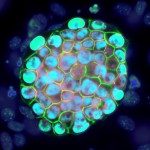Lien vers Pubmed [PMID] – 7520149
Oncogene 1994 Sep;9(9):2655-61
Mutations at the mouse W/c-kit locus have pleiotropic defects including impaired development of the melanocyte lineage. We have characterized the molecular basis of the Wei mutation. We show here that Wei is the result of a missense mutation in the ATP binding site domain of c-kit proto-oncogene which affects the tyrosine kinase function of the receptor. As a result, few melanoblasts survive during embryogenesis in heterozygous Wei/+ foetuses. Therefore the adult skin is partly devoid of differentiated pigmented cells giving rise to a mottled coat colour phenotype. However, three per cent of Wei/+ mice exhibit spots of wild-type pigmentation on the coat which is otherwise of mutant phenotype. Such areas are known as phenotypic reversions. To dissect the molecular events responsible for the phenotypic instability of the Wei mutation, we have isolated pure cultures of continuously proliferating melanocytes from two independent reversion spots. These melanocyte lines, designated Wei-R1 and Wei-R2, were shown to exhibit none of the characteristics associated with transformed melanocytes. We have used a polymorphic restriction site generated by the Wei mutation to show that both melanocyte lines are still heterozygous at the W focus. Furthermore, Wei-R1 and Wei-R2 melanocytes express both the mutated and the wild-type c-kit RNA. These results indicate that the somatic mutation events responsible for reversion spots are not necessarily associated with loss of heterozygosity at the W/c-kit locus. Together with previous data, this points to the fact that several mechanisms account for the coat colour reversion phenotype.

